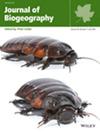Orchid Mycorrhizal Communities Associated With Orchis italica Are Shaped by Ecological Factors and Geographical Gradients
Abstract
Aim
The influence of mutualists on plant distributions is only beginning to be understood. Orchids depend on orchid mycorrhizal (OrM) fungi to germinate, yet the distribution of OrM fungi and how they vary according to both abiotic and biotic factors is unclear. We investigated the abundance and diversity of OrM fungal communities associated with the Mediterranean orchid Orchis italica and quantified how they vary according to both geographical and ecological factors.
Location
Mediterranean basin.
Taxon
Orchis italica Poir. (Orchidaceae).
Methods
We used metabarcoding of the ITS2 region to identify OrM fungi associated with adult individuals in 23 populations of O. italica across latitudinal and longitudinal gradients in the Mediterranean region. We used both multivariate analyses and Joint Species Distribution Models (JSDMs) based on geographical, climate, and soil variables to test how both common OrM fungi and their communities vary according to geographical and ecological factors.
Results
Eighty OrM fungal Operational Taxonomic Units (OTUs) were found associating with O. italica. However, five Tulasnellaceae OTUs and one Ceratobasidiaceae OTU were found in every population. Abundance of these taxa, as measured by number of reads, increased from west to east and decreased from South to North, indicating OrM fungal abundance may be determined by geographical gradients. OrM fungal community composition varied according to precipitation, annual mean temperature, and soil phosphorous content. JSDMs revealed there were both positive and negative co-occurrences among these ubiquitous OrM fungal OTUs.
Main Conclusions
Despite associating with many OrM fungi across its range, only six OTUs were widespread, indicating that O. italica may be an apparent generalist in its association with OrM fungi. Abundance of OrM fungi is determined by geographical gradients and their community composition determined by ecological factors. This highlights the importance of quantifying the distribution of belowground mutualists in understanding the limits to plant distributions.


 求助内容:
求助内容: 应助结果提醒方式:
应助结果提醒方式:


